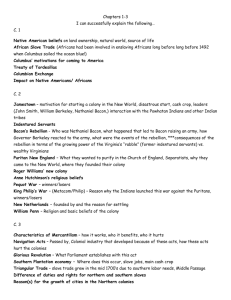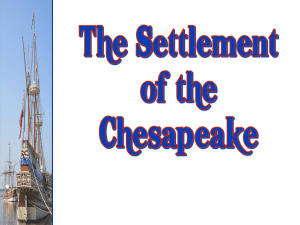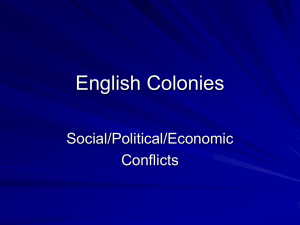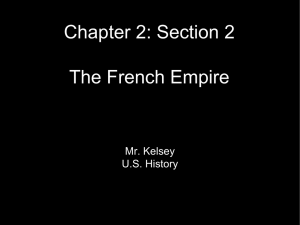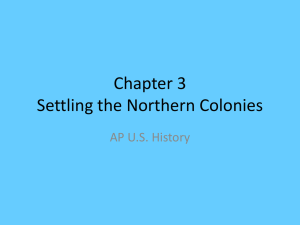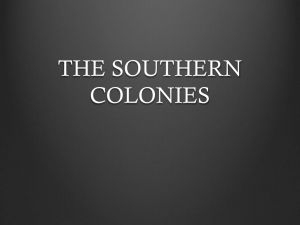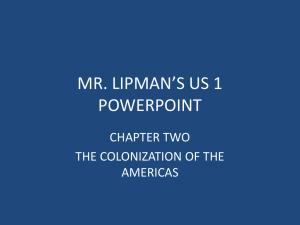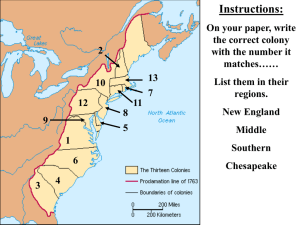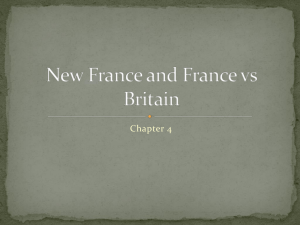America`s History Chapter 2
advertisement
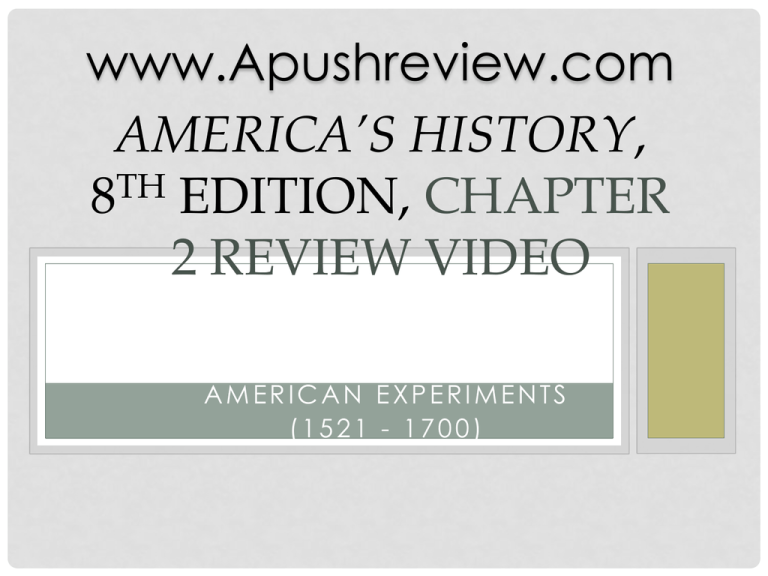
www.Apushreview.com AMERICA’S HISTORY, 8TH EDITION, CHAPTER 2 REVIEW VIDEO AMERICAN EXPERIMENTS (1521 - 1700) CHATTEL SLAVERY • Virginia and Maryland – 1660s • Legally defined chattel slavery • The status of the child would be determined based on the MOTHER and not the FATHER • Ran contradictory to English law • Children born to slave owners and slave mothers were automatically slaves SPAIN’S TRIBUTE COLONIES • A New American World: • Encomienda System – Spanish conquistadors received land from the crown • Based almost entirely on Indian slave labor • Very harsh, yet profitable • Spanish social classes: • Mestizos, Mulattos, and Zambos emerged • Many Spanish priests sought to convert Indians • The Columbian Exchange • Exchange of goods, people, disease, and ideas between Europe, Africa, and Americas • New crops were introduced to Europe – potato, maize • Horse had large impact on Indian life • In some areas, 90% of Indian population decreased • The Protestant Challenge to Spain • England began to build up its navy in the 16th century • Mercantilism – purpose was to benefit the Mother Country (England) by exporting more goods than importing PLANTATION COLONIES • Plantations in the Americas grew as a result of increased demand for sugar and tobacco • Brazil’s Sugar Plantations: • Very arduous labor, milling was done on site • As Indian populations declined, African slave labor was introduced • England’s Tobacco Colonies: • Jamestown: (1607) • Joint Stock Company (investors shared in profits and losses of colony) • Originally all men, hoped to gain gold • Eventually, tobacco became a major cash crop, but exhausted the land -> encroach on Indian land • House of Burgesses – first representative government in US (1619) • The Indian War of 1622: • 1/3 of Jamestown population was killed by Indian attacks, English retaliated • Jamestown became a royal colony in 1624 – colonists had to pay taxes to support the Church of England • Lord Baltimore Settles Catholics in Maryland: • Proprietor colony – royal grant of land granted by the King • Maryland Acts of Toleration (1649) – granted religious freedom to CHRISTIANS only, particularly Catholics • Maryland relied heavily on tobacco, like the other Chesapeake colony, Virginia PLANTATION COLONIES CONT. • The Caribbean Islands: • Like Brazil, these colonies focused on sugar production • Plantation Life: • Planation's grew in part, due to the Headright System: • Gave 50 acres of land to someone who paid for an immigrant’s passage – benefited the rich • Indentured Servitude: • In return for passage, individuals would work 4-5 years, then could be free • ½ of all servants died before they became free • Used extensively in the Chesapeake colonies in 17th century • African Laborers: • Used more heavily in the Caribbean originally (sugar) • Used more in the Chesapeake due to Bacon’s Rebellion and it was cheaper than indentured servants • Strict laws developed that promoted racism and regulated behavior of blacks NEW-EUROPEAN COLONIES • New France: • Expanded into the North American interior (Canada) • Quebec was established as a trading post (fur) • Established Jesuit priests sought to convert Indians • Coureurs de bois – French fur traders • New Netherland: • New Amsterdam (Manhattan) was a small colony, but engaged in significant commerce • Like the French, the Dutch traded furs • The Rise of the Iroquois: • Located in central and Western NY • Treaded weapons and goods with the Dutch and French • Remained a strong force in NY NEW-EUROPEAN COLONIES CONT. • New England: • The Pilgrims • Separatists that wanted to break away from the Church of England • Plymouth’s climate was not as harsh as the Chesapeake • Representative self-government was established • Puritans – wanted to purify the English Church, NOT separate from it • John Winthrop and Massachusetts Bay: • Sought to establish a “City Upon a Hill” • Believed in predestination • Church members had tremendous power – only ones that could vote; not religiously tolerant • Roger Williams and Rhode Island: • Advocated separation of church and state, religious toleration, and friendly relations with Indians • Banished to Rhode Island by Winthrop • No legally established church in RI NEW-EUROPEAN COLONIES CONT. • Anne Hutchinson: • • • • Seen as a major threat to Puritans Challenged gender roles in Church Claimed to have direct revelations with God Banished from MBC • Puritanism and Witchcraft: • Salem Witch Trials: • Hysteria throughout MA in late 17th century • Accused tended to be wealthier, widowed, and middle-ages • Reflected religious and social tensions • Most of the accused were “independent” which challenged Puritan society • After the hysteria ended, prosecution for witchcraft declined • Many colonists started to embrace ideas of the Enlightenment INSTABILITY, WAR, AND REBELLION • New England’s Indian Wars: • Puritan-Pequot War: • Pequots were allied with the Dutch, had conflicts with English settlers • 500 men, women, and children were massacred by Indians, New England retaliated harshly and gained land • Some settlers saw smallpox and other diseases that decimated Indians as doing “God’s work” (John Winthrop) • Metacom’s War, 1675 – 1676: • Metacom (King Philip) was a leader of the Wampanoags • Metacom was eventually killed and Natives were rarely a threat in New England after INSTABILITY, WAR, AND REBELLION CONT. • Bacon’s Rebellion: • Gov. Berkeley did not allow settlement past a line • In the “west” many famers were underrepresented in the House of Burgesses • Conflict between Natives and “westerners” like Bacon • Bacon almost took control, died suddenly • Significance? • Movement towards slaves for labor • Shows tensions between rich and poor, East and West QUICK RECAP • Columbian Exchange included diseases as well as goods (potatoes, maize, horses) • MD Acts of Toleration applied to ONLY Christians • Headright System and indentured servants • Chesapeake focused on indentured servants and tobacco -> expansion on Indian land • New France traded and had friendly relations with Indians • No religious toleration in MBC: Roger Williams and Anne Hutchinson • Bacon’s Rebellion showed tensions between “east and west” or “rich v. poor” and led to an increase in slavery THANKS FOR WATCHING! Subscribe to my channel Press the “Like” button • Questions? Comments? Follow me on Twitter @APUSH_Review
